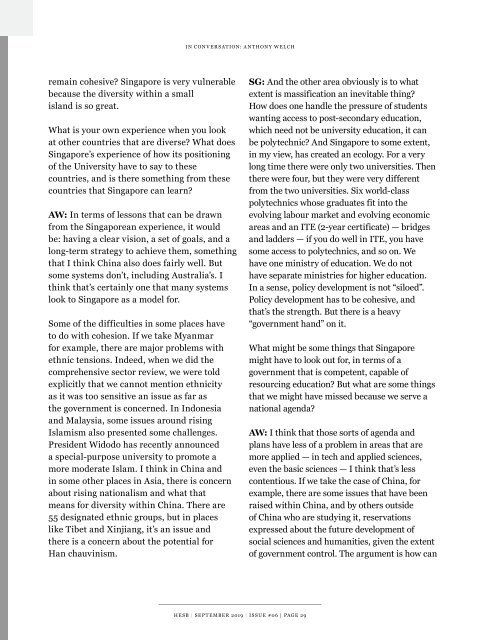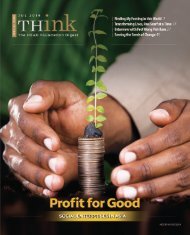Higher Education in Southeast Asia and Beyond #Issue 06
In this special issue, we feature articles arising from the 6th Global Higher Education Form 2018 (GHEF 6.0) held from 8 to 10 October 2018 in Putrajaya, Malaysia. We also look at China's influence and relationships in higher education, among other topics.
In this special issue, we feature articles arising from the 6th Global Higher Education Form 2018 (GHEF 6.0) held from 8 to 10 October 2018 in Putrajaya, Malaysia. We also look at China's influence and relationships in higher education, among other topics.
Create successful ePaper yourself
Turn your PDF publications into a flip-book with our unique Google optimized e-Paper software.
IN CONVERSATION: ANTHONY WELCH<br />
rema<strong>in</strong> cohesive? S<strong>in</strong>gapore is very vulnerable<br />
because the diversity with<strong>in</strong> a small<br />
isl<strong>and</strong> is so great.<br />
What is your own experience when you look<br />
at other countries that are diverse? What does<br />
S<strong>in</strong>gapore’s experience of how its position<strong>in</strong>g<br />
of the University have to say to these<br />
countries, <strong>and</strong> is there someth<strong>in</strong>g from these<br />
countries that S<strong>in</strong>gapore can learn?<br />
AW: In terms of lessons that can be drawn<br />
from the S<strong>in</strong>gaporean experience, it would<br />
be: hav<strong>in</strong>g a clear vision, a set of goals, <strong>and</strong> a<br />
long-term strategy to achieve them, someth<strong>in</strong>g<br />
that I th<strong>in</strong>k Ch<strong>in</strong>a also does fairly well. But<br />
some systems don’t, <strong>in</strong>clud<strong>in</strong>g Australia’s. I<br />
th<strong>in</strong>k that’s certa<strong>in</strong>ly one that many systems<br />
look to S<strong>in</strong>gapore as a model for.<br />
Some of the difficulties <strong>in</strong> some places have<br />
to do with cohesion. If we take Myanmar<br />
for example, there are major problems with<br />
ethnic tensions. Indeed, when we did the<br />
comprehensive sector review, we were told<br />
explicitly that we cannot mention ethnicity<br />
as it was too sensitive an issue as far as<br />
the government is concerned. In Indonesia<br />
<strong>and</strong> Malaysia, some issues around ris<strong>in</strong>g<br />
Islamism also presented some challenges.<br />
President Widodo has recently announced<br />
a special-purpose university to promote a<br />
more moderate Islam. I th<strong>in</strong>k <strong>in</strong> Ch<strong>in</strong>a <strong>and</strong><br />
<strong>in</strong> some other places <strong>in</strong> <strong>Asia</strong>, there is concern<br />
about ris<strong>in</strong>g nationalism <strong>and</strong> what that<br />
means for diversity with<strong>in</strong> Ch<strong>in</strong>a. There are<br />
55 designated ethnic groups, but <strong>in</strong> places<br />
like Tibet <strong>and</strong> X<strong>in</strong>jiang, it’s an issue <strong>and</strong><br />
there is a concern about the potential for<br />
Han chauv<strong>in</strong>ism.<br />
SG: And the other area obviously is to what<br />
extent is massification an <strong>in</strong>evitable th<strong>in</strong>g?<br />
How does one h<strong>and</strong>le the pressure of students<br />
want<strong>in</strong>g access to post-secondary education,<br />
which need not be university education, it can<br />
be polytechnic? And S<strong>in</strong>gapore to some extent,<br />
<strong>in</strong> my view, has created an ecology. For a very<br />
long time there were only two universities. Then<br />
there were four, but they were very different<br />
from the two universities. Six world-class<br />
polytechnics whose graduates fit <strong>in</strong>to the<br />
evolv<strong>in</strong>g labour market <strong>and</strong> evolv<strong>in</strong>g economic<br />
areas <strong>and</strong> an ITE (2-year certificate) — bridges<br />
<strong>and</strong> ladders — if you do well <strong>in</strong> ITE, you have<br />
some access to polytechnics, <strong>and</strong> so on. We<br />
have one m<strong>in</strong>istry of education. We do not<br />
have separate m<strong>in</strong>istries for higher education.<br />
In a sense, policy development is not “siloed”.<br />
Policy development has to be cohesive, <strong>and</strong><br />
that’s the strength. But there is a heavy<br />
“government h<strong>and</strong>” on it.<br />
What might be some th<strong>in</strong>gs that S<strong>in</strong>gapore<br />
might have to look out for, <strong>in</strong> terms of a<br />
government that is competent, capable of<br />
resourc<strong>in</strong>g education? But what are some th<strong>in</strong>gs<br />
that we might have missed because we serve a<br />
national agenda?<br />
AW: I th<strong>in</strong>k that those sorts of agenda <strong>and</strong><br />
plans have less of a problem <strong>in</strong> areas that are<br />
more applied — <strong>in</strong> tech <strong>and</strong> applied sciences,<br />
even the basic sciences — I th<strong>in</strong>k that’s less<br />
contentious. If we take the case of Ch<strong>in</strong>a, for<br />
example, there are some issues that have been<br />
raised with<strong>in</strong> Ch<strong>in</strong>a, <strong>and</strong> by others outside<br />
of Ch<strong>in</strong>a who are study<strong>in</strong>g it, reservations<br />
expressed about the future development of<br />
social sciences <strong>and</strong> humanities, given the extent<br />
of government control. The argument is how can<br />
HESB | SEPTEMBER 2019 | ISSUE #<strong>06</strong> | PAGE 29





